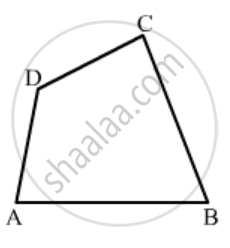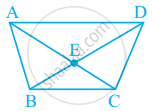Advertisements
Advertisements
प्रश्न
The angles of a hexagon are (2x + 5)°, (3x - 5)°, (x + 40)°, (2x + 20)°, (2x + 25)° and (2x + 35)°. Find the value of x.
उत्तर
A hexagon has 6 sides
∴ Sum of interior angles
= (n - 2) x 180°
= (6 - 2) x 180°
= 4 x 180°
= 720°
Given the angle of a hexagon are (2x + 5)°, (3x - 5)°, (x + 40)°, (2x + 20)°, (2x + 25)° and (2x + 35)°
∴ (2x + 5)°, + (3x - 5)°, + (x + 40)°, + (2x + 20)°, + (2x + 25)° +(2x + 35)° = 720
⇒ 12x + 120° = 720°
⇒ x = 50°.
APPEARS IN
संबंधित प्रश्न
In a quadrilateral, define of the following Opposite angles .
In Fig. 16.19, ABCD is a quadrilateral.
How many pairs of adjacent sides are there?

The measure of angles of a hexagon are x°, (x − 5)°, (x − 5)°, (2x − 5)°, (2x − 5)°, (2x + 20)°. Find the value of x.
The sum of the interior angles of a polygon is three times the sum of its exterior angles. Determine the number of sided of the polygon.
PQRSTU is a regular hexagon. Determine each angle of ΔPQT.
Two angles of a quadrilateral are 89° and 113°. If the other two angles are equal; find the equal angles.
Angles of a quadrilateral are (4x)°, 5(x+2)°, (7x – 20)° and 6(x+3)°. Find :
(i) the value of x.
(ii) each angle of the quadrilateral.
In a quadrilateral ABCD, ∠A = 72° and ∠C is the supplementary of ∠A. The other two angles are 2x – 10 and x + 4. Find the value of x and the measure of all the angles
If the sum of two angles is equal to an obtuse angle, then which of the following is not possible?
In given figure, What is BD – BE?
